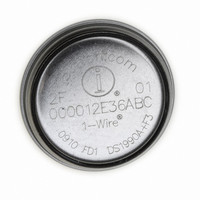DS1904L-F5# Maxim Integrated Products, DS1904L-F5# Datasheet - Page 7

DS1904L-F5#
Manufacturer Part Number
DS1904L-F5#
Description
IBUTTON RTC F5 MICROCAN
Manufacturer
Maxim Integrated Products
Series
iButton®r
Datasheet
1.DS1904L-F5.pdf
(13 pages)
Specifications of DS1904L-F5#
Rohs Information
IButton RoHS Compliance Plan
Lead Free Status / RoHS Status
Lead free / RoHS Compliant
Memory Size
-
Memory Type
-
Lead Free Status / Rohs Status
Lead free / RoHS Compliant
Available stocks
Company
Part Number
Manufacturer
Quantity
Price
DS1904
The idle state for the 1-Wire bus is high. If for any reason a transaction needs to be suspended, the bus
MUST be left in the idle state if the transaction is to resume. If this does not occur and the bus is left low
for more than 120 s, one or more of the devices on the bus may be reset. Since the DS1904 gets all its
energy for operation through its V
pin it will NOT perform a power-on reset if the 1-Wire bus is low
DD
for an extended time period.
Transaction Sequence
The protocol for accessing the DS1904 via the 1-Wire port is as follows:
Initialization
ROM Function Command
Clock Function Command
INITIALIZATION
All transactions on the 1-Wire bus begin with an initialization sequence. The initialization sequence con-
sists of a reset pulse transmitted by the bus master followed by presence pulse(s) transmitted by the
slave(s). The presence pulse lets the bus master know that the DS1904 is on the bus and is ready to
operate. For more details, see the “1-Wire Signaling” section.
ROM FUNCTION COMMANDS
Once the bus master has detected a presence, it can issue one of the four ROM function commands that
the DS1904 supports. All ROM function commands are eight bits long. A list of these commands follows
(refer to flowchart in Figure 7):
Read ROM [33h]
This command allows the bus master to read the DS1904’s 8-bit family code, unique 48-bit serial num-
ber, and 8-bit CRC. This command should only be used if there is a single slave on the bus. If more than
one slave is present on the bus, a data collision will occur when all slaves try to transmit at the same time
(open drain will produce a wired-AND result). The resultant family code and 48-bit serial number read by
the master will be invalid.
Match ROM [55h]
The match ROM command, followed by a 64-bit ROM sequence, allows the bus master to address a spe-
cific DS1904 on a multidrop bus. Only the DS1904 that exactly matches the 64-bit ROM sequence will
respond to the following clock function command. All slaves that do not match the 64-bit ROM sequence
will wait for a reset pulse. This command can be used with a single or multiple devices on the bus.
SEARCH ROM [F0h]
When a system is initially brought up, the bus master might not know the number of devices on the 1-
Wire bus or their 64-bit ROM codes. The search ROM command allows the bus master to use a process
of elimination to identify the 64-bit ROM codes of all slave devices on the bus. The search ROM process
is the repetition of a simple 3-step routine: read a bit, read the complement of the bit, then write the de-
sired value of that bit. The bus master performs this 3-step routine on each bit of the ROM. After one
complete pass, the bus master knows the 64-bit ROM code of one device. Additional passes will identify
the ROM codes of the remaining devices. See Chapter 5 of the Book of DS19xx iButton Standards for a
comprehensive discussion of a search ROM, including an actual example.
7 of 13












